Page 306 of 481
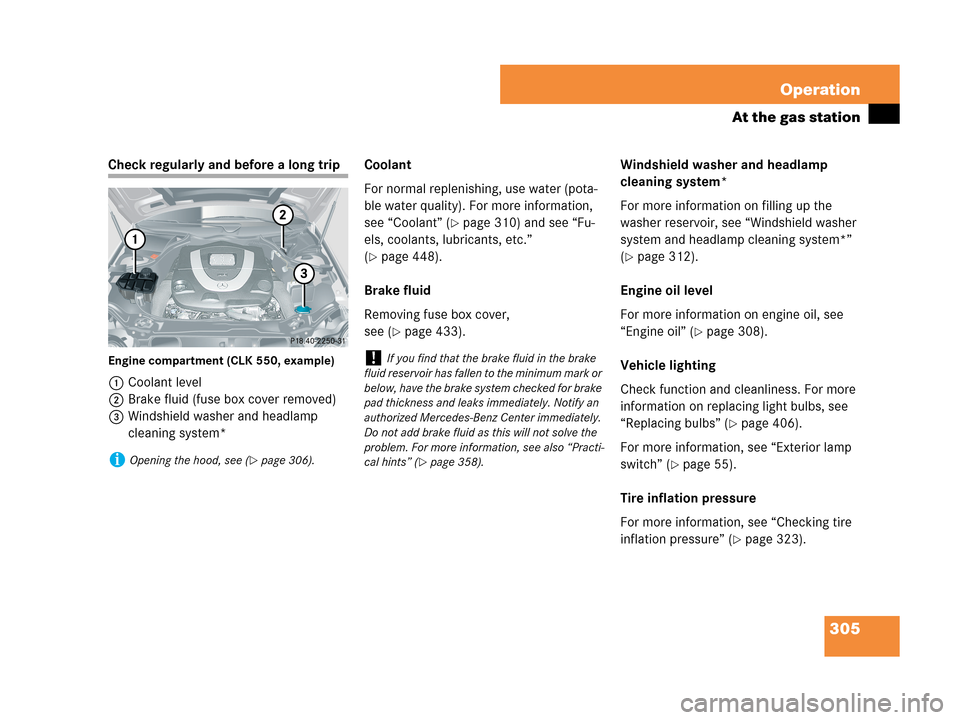
305 Operation
At the gas station
Check regularly and before a long trip
Engine compartment (CLK 550, example)
1Coolant level
2Brake fluid (fuse box cover removed)
3Windshield washer and headlamp
cleaning system*Coolant
For normal replenishing, use water (pota-
ble water quality). For more information,
see “Coolant” (
�page 310) and see “Fu-
els, coolants, lubricants, etc.”
(
�page 448).
Brake fluid
Removing fuse box cover,
see (
�page 433).Windshield washer and headlamp
cleaning system*
For more information on filling up the
washer reservoir, see “Windshield washer
system and headlamp cleaning system*”
(
�page 312).
Engine oil level
For more information on engine oil, see
“Engine oil” (
�page 308).
Vehicle lighting
Check function and cleanliness. For more
information on replacing light bulbs, see
“Replacing bulbs” (
�page 406).
For more information, see “Exterior lamp
switch” (
�page 55).
Tire inflation pressure
For more information, see “Checking tire
inflation pressure” (
�page 323).
iOpening the hood, see (�page 306).
!If you find that the brake fluid in the brake
fluid reservoir has fallen to the minimum mark or
below, have the brake system checked for brake
pad thickness and leaks immediately. Notify an
authorized Mercedes-Benz Center immediately.
Do not add brake fluid as this will not solve the
problem. For more information, see also “Practi-
cal hints” (
�page 358).
Page 307 of 481
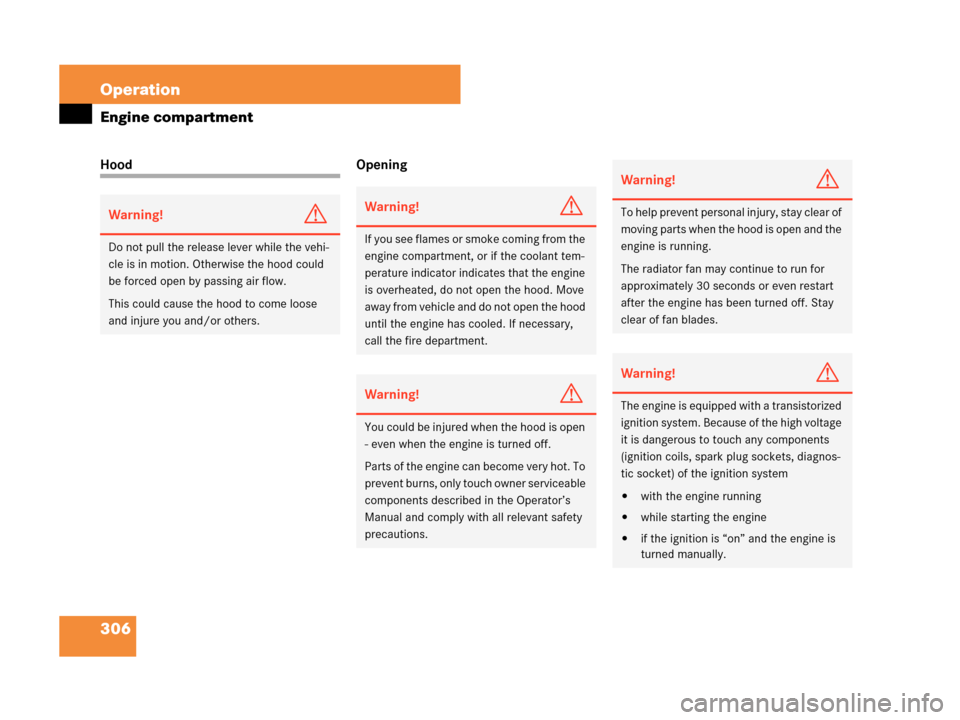
306 Operation
Engine compartment
Hood Opening
Warning!G
Do not pull the release lever while the vehi-
cle is in motion. Otherwise the hood could
be forced open by passing air flow.
This could cause the hood to come loose
and injure you and/or others.
Warning!G
If you see flames or smoke coming from the
engine compartment, or if the coolant tem-
perature indicator indicates that the engine
is overheated, do not open the hood. Move
away from vehicle and do not open the hood
until the engine has cooled. If necessary,
call the fire department.
Warning!G
You could be injured when the hood is open
- even when the engine is turned off.
Parts of the engine can become very hot. To
prevent burns, only touch owner serviceable
components described in the Operator’s
Manual and comply with all relevant safety
precautions.
Warning!G
To help prevent personal injury, stay clear of
moving parts when the hood is open and the
engine is running.
The radiator fan may continue to run for
approximately 30 seconds or even restart
after the engine has been turned off. Stay
clear of fan blades.
Warning!G
The engine is equipped with a transistorized
ignition system. Because of the high voltage
it is dangerous to touch any components
(ignition coils, spark plug sockets, diagnos-
tic socket) of the ignition system
�with the engine running
�while starting the engine
�if the ignition is “on” and the engine is
turned manually.
Page 310 of 481
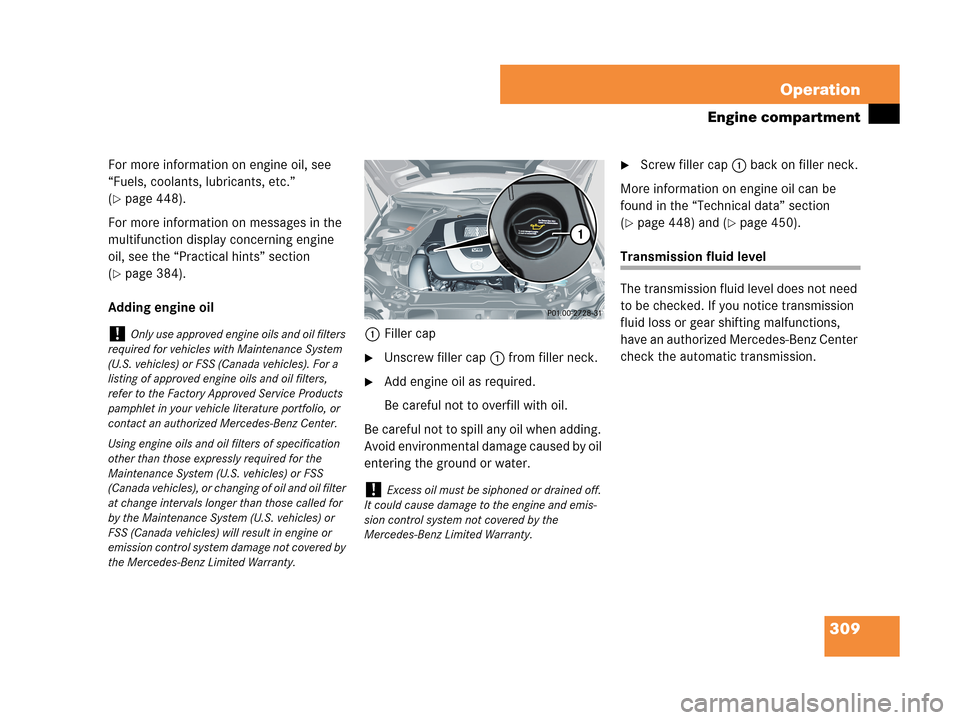
309 Operation
Engine compartment
For more information on engine oil, see
“Fuels, coolants, lubricants, etc.”
(
�page 448).
For more information on messages in the
multifunction display concerning engine
oil, see the “Practical hints” section
(
�page 384).
Adding engine oil
1Filler cap
�Unscrew filler cap1 from filler neck.
�Add engine oil as required.
Be careful not to overfill with oil.
Be careful not to spill any oil when adding.
Avoid environmental damage caused by oil
entering the ground or water.
�Screw filler cap1 back on filler neck.
More information on engine oil can be
found in the “Technical data” section
(
�page 448) and (�page 450).
Transmission fluid level
The transmission fluid level does not need
to be checked. If you notice transmission
fluid loss or gear shifting malfunctions,
have an authorized Mercedes-Benz Center
check the automatic transmission.
!Only use approved engine oils and oil filters
required for vehicles with Maintenance System
(U.S. vehicles) or FSS (Canada vehicles). For a
listing of approved engine oils and oil filters,
refer to the Factory Approved Service Products
pamphlet in your vehicle literature portfolio, or
contact an authorized Mercedes-Benz Center.
Using engine oils and oil filters of specification
other than those expressly required for the
Maintenance System (U.S. vehicles) or FSS
(Canada vehicles), or changing of oil and oil filter
at change intervals longer than those called for
by the Maintenance System (U.S. vehicles) or
FSS (Canada vehicles) will result in engine or
emission control system damage not covered by
the Mercedes-Benz Limited Warranty.
!Excess oil must be siphoned or drained off.
It could cause damage to the engine and emis-
sion control system not covered by the
Mercedes-Benz Limited Warranty.
Page 311 of 481
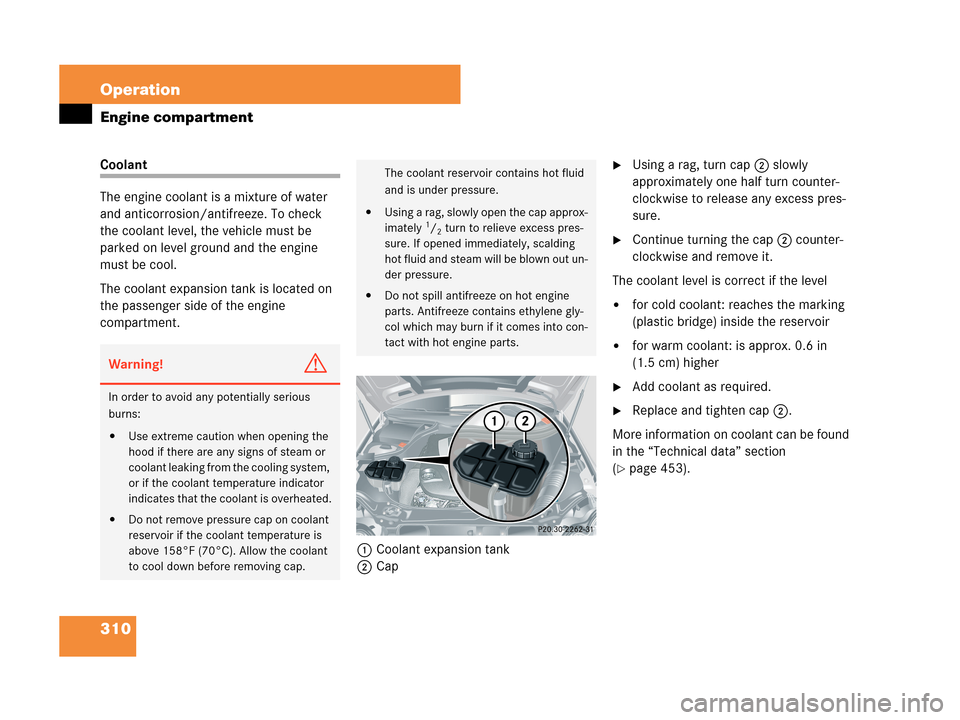
310 Operation
Engine compartment
Coolant
The engine coolant is a mixture of water
and anticorrosion/antifreeze. To check
the coolant level, the vehicle must be
parked on level ground and the engine
must be cool.
The coolant expansion tank is located on
the passenger side of the engine
compartment.
1Coolant expansion tank
2Cap�Using a rag, turn cap 2 slowly
approximately one half turn counter-
clockwise to release any excess pres-
sure.
�Continue turning the cap 2 counter-
clockwise and remove it.
The coolant level is correct if the level
�for cold coolant: reaches the marking
(plastic bridge) inside the reservoir
�for warm coolant: is approx. 0.6 in
(1.5 cm) higher
�Add coolant as required.
�Replace and tighten cap 2.
More information on coolant can be found
in the “Technical data” section
(
�page 453).
Warning!G
In order to avoid any potentially serious
burns:
�Use extreme caution when opening the
hood if there are any signs of steam or
coolant leaking from the cooling system,
or if the coolant temperature indicator
indicates that the coolant is overheated.
�Do not remove pressure cap on coolant
reservoir if the coolant temperature is
above 158°F (70°C). Allow the coolant
to cool down before removing cap.
The coolant reservoir contains hot fluid
and is under pressure.
�Using a rag, slowly open the cap approx-
imately 1/2 turn to relieve excess pres-
sure. If opened immediately, scalding
hot fluid and steam will be blown out un-
der pressure.
�Do not spill antifreeze on hot engine
parts. Antifreeze contains ethylene gly-
col which may burn if it comes into con-
tact with hot engine parts.
Page 362 of 481
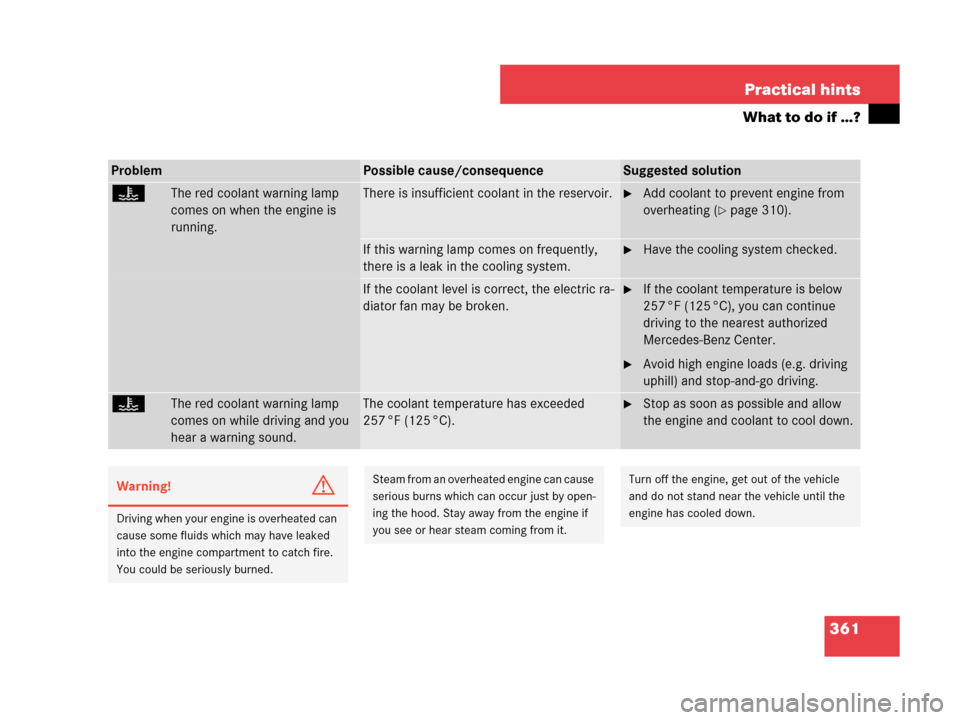
361 Practical hints
What to do if …?
ProblemPossible cause/consequenceSuggested solution
•The red coolant warning lamp
comes on when the engine is
running.There is insufficient coolant in the reservoir.�Add coolant to prevent engine from
overheating (
�page 310).
If this warning lamp comes on frequently,
there is a leak in the cooling system.�Have the cooling system checked.
If the coolant level is correct, the electric ra-
diator fan may be broken.�If the coolant temperature is below
257 °F (125 °C), you can continue
driving to the nearest authorized
Mercedes-Benz Center.
�Avoid high engine loads (e.g. driving
uphill) and stop-and-go driving.
•The red coolant warning lamp
comes on while driving and you
hear a warning sound.The coolant temperature has exceeded
257 °F (125 °C).�Stop as soon as possible and allow
the engine and coolant to cool down.
Warning!G
Driving when your engine is overheated can
cause some fluids which may have leaked
into the engine compartment to catch fire.
You could be seriously burned.
Steam from an overheated engine can cause
serious burns which can occur just by open-
ing the hood. Stay away from the engine if
you see or hear steam coming from it.Turn off the engine, get out of the vehicle
and do not stand near the vehicle until the
engine has cooled down.
Page 381 of 481
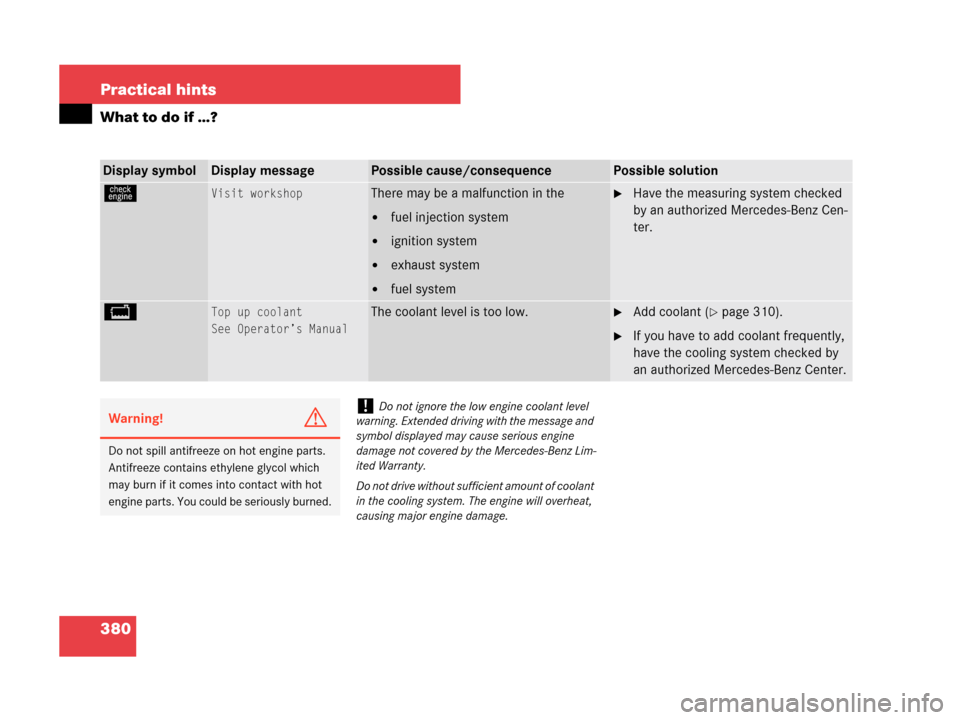
380 Practical hints
What to do if …?
Display symbolDisplay messagePossible cause/consequencePossible solution
úVisit workshopThere may be a malfunction in the
�fuel injection system
�ignition system
�exhaust system
�fuel system
�Have the measuring system checked
by an authorized Mercedes-Benz Cen-
ter.
B Top up coolant
See Operator’s ManualThe coolant level is too low.�Add coolant (�page 310).
�If you have to add coolant frequently,
have the cooling system checked by
an authorized Mercedes-Benz Center.
Warning!G
Do not spill antifreeze on hot engine parts.
Antifreeze contains ethylene glycol which
may burn if it comes into contact with hot
engine parts. You could be seriously burned.
!Do not ignore the low engine coolant level
warning. Extended driving with the message and
symbol displayed may cause serious engine
damage not covered by the Mercedes-Benz Lim-
ited Warranty.
Do not drive without sufficient amount of coolant
in the cooling system. The engine will overheat,
causing major engine damage.
Page 382 of 481
381 Practical hints
What to do if …?
Display symbolDisplay messagePossible cause/consequencePossible solution
•Coolant
Stop, turn engine offThe coolant is too hot.
Among other possible causes, the
poly-V-belt could be broken.�Stop the vehicle in a safe location or
as soon as it is safe to do so.
�Apply the parking brake (�page 59).
�Turn off the engine.
�Check the poly-V-belt.
If it is broken:
�Do not continue to drive. Otherwise
the engine will overheat due to an in-
operative water pump which may re-
sult in damage to the engine. Contact
an authorized Mercedes-Benz Center.
If it is intact:
�Wait for the message to disappear be-
fore restarting the engine.
Doing otherwise could result in seri-
ous engine damage that is not covered
by the Mercedes-Benz Limited War-
ranty.
(Continued on next page)
Page 383 of 481
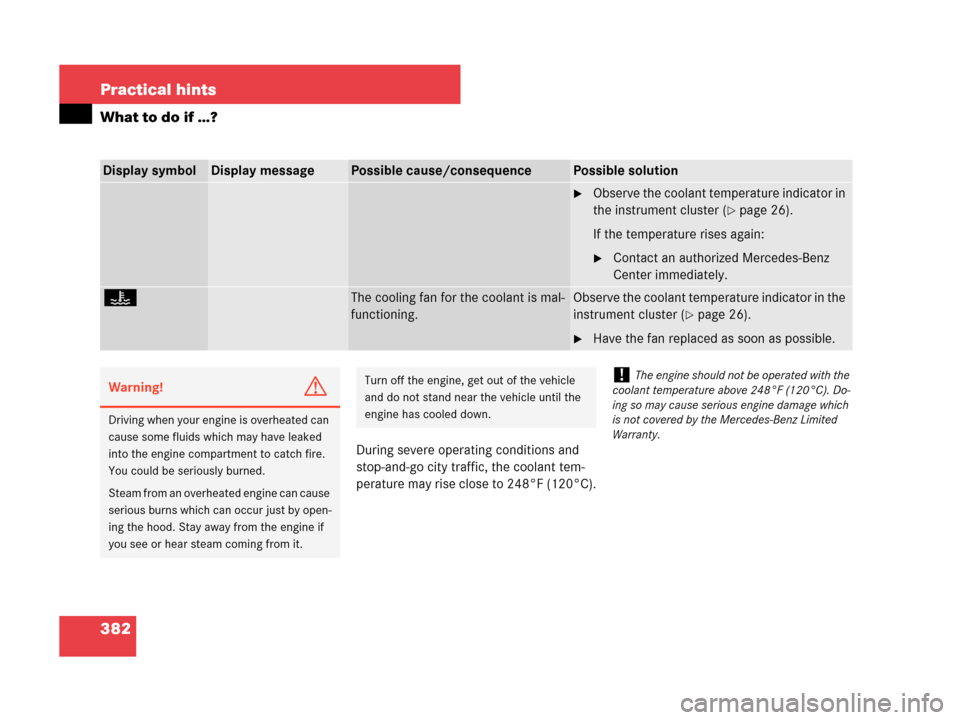
382 Practical hints
What to do if …?
During severe operating conditions and
stop-and-go city traffic, the coolant tem-
perature may rise close to 248°F (120°C).
Display symbolDisplay messagePossible cause/consequencePossible solution
�Observe the coolant temperature indicator in
the instrument cluster (
�page 26).
If the temperature rises again:
�Contact an authorized Mercedes-Benz
Center immediately.
•The cooling fan for the coolant is mal-
functioning.Observe the coolant temperature indicator in the
instrument cluster (
�page 26).
�Have the fan replaced as soon as possible.
Warning!G
Driving when your engine is overheated can
cause some fluids which may have leaked
into the engine compartment to catch fire.
You could be seriously burned.
Steam from an overheated engine can cause
serious burns which can occur just by open-
ing the hood. Stay away from the engine if
you see or hear steam coming from it.
Turn off the engine, get out of the vehicle
and do not stand near the vehicle until the
engine has cooled down.!The engine should not be operated with the
coolant temperature above 248°F (120°C). Do-
ing so may cause serious engine damage which
is not covered by the Mercedes-Benz Limited
Warranty.